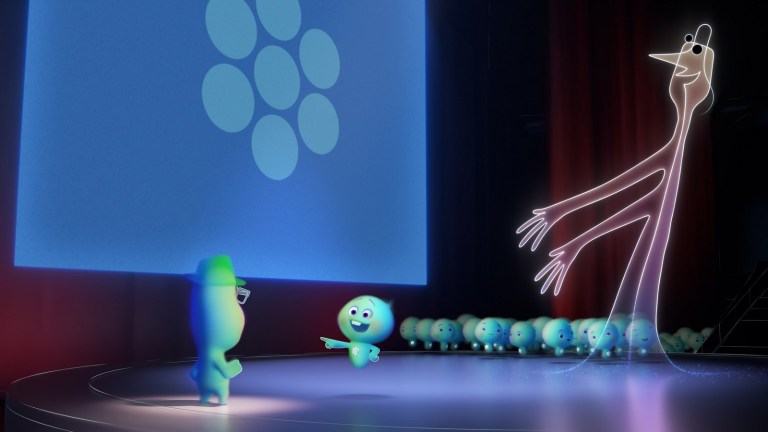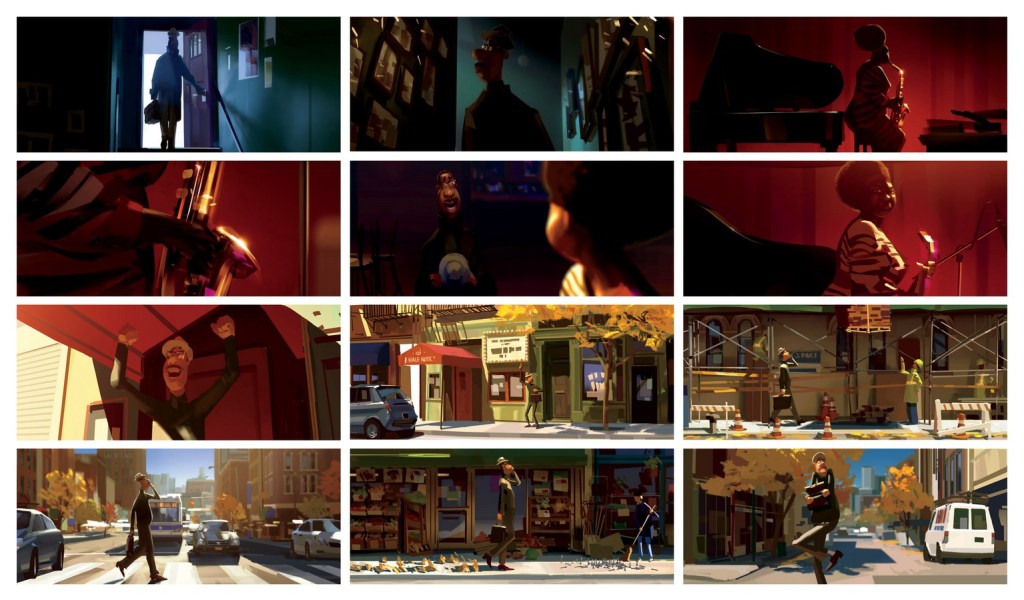Inside Pixar’s Soul and the Secrets of Life Before Death
Soul is Inside Out director Pete Docter’s new exploration of one of life’s great questions: where do we come from?

In 2015 Pixar and director Pete Docter brought us Inside Out, a brilliant, moving exploration of how our emotions affect our relationships as we grow older. The Oscar-winning film’s script (by Docter, Meg LeFauve, and Josh Cooley) was heavily inspired by the filmmakers’ research into neuropsychology and the mysteries of how the human mind works. Now five years later, Docter and a new team have gone in a completely different direction–the metaphysical–with Soul.
Den of Geek was given a chance to view the first 20 minutes of the film and speak afterward with Docter, co-writer Kemp Powers, and producer Dana Murray about what may be Pixar’s most unabashedly gorgeous and advanced animated film to date.
Soul stars Jamie Foxx as the voice of Joe Gardner, a New York City middle school teacher whose dream of becoming a professional jazz musician seems to end prematurely when an accident sends him to The Great Before. This is the surreal plane of existence where new, relatively unformed souls are given their personalities and traits by older, wiser souls known as mentors, before being shipped off to Earth.
Convinced he’s not supposed to be there, Joe nevertheless becomes the mentor of 22 (Tina Fey), a soul who has no interest in developing a personality and thus heading off to life in the real world. But Joe sees 22 as his means to get back to life, and he becomes determined to help her find the spark of life she’s missing while learning a few new things about himself as well.
“That’s actually the cornerstone of our story, a soul that doesn’t want to live, looks down on Earth with skepticism, and says, ‘Is all that living really worth it down there?’” Docter explains during a press presentation about the film. “So the basic concept of the film was formed, a soul who doesn’t want to go live meets a soul who doesn’t want to die.”
Docter continues, “But if we were going to make a film about souls, our first problem was what does a soul look like? So we did a lot of research, looking into the teachings, many philosophies and traditions around the world, and what we found most was that people described the soul as vapor, non-physical, formless, breath, air. All very interesting, but not very helpful, because how do you draw air?”
Speaking directly with Den of Geek a short time after the press presentation, Docter says that he had a “great time” exploring the spiritual and metaphysical underpinnings of his movie: “I met with a rabbi, we spoke with a Buddhist… spiritual people from all walks of life. Even a shaman, who came in and wanted to take us on a journey, and we’re like, ‘Oh, look at the time. We’re out of time.’ We were a little scared, I guess. But it was great, because it really exercises and challenges you.”
Docter and Murray both admit that exploring the nature of the soul itself gave them a different perspective on their own lives and personalities. “I feel like at the end, even looking back at other films that we’ve done in the past, I probably wouldn’t make a Monsters, Inc. the same way,” Docter says. “I might not even make it at all, because the films have changed who I am and where my interests lie.”
Murray agrees as she adds, “Absolutely, I think I changed over the course of the project. But the one thing is I probably started the project really doubting myself, and over time learned to trust myself that I’m pretty damn good at what I do. I think you grow in that way, as well.”
Pondering the nature of the soul and the afterlife (and the before-life) is one thing; visualizing it on screen is another, and both Docter and Kemp are upfront about the challenges of creating a visual representation of things that are most likely beyond human comprehension. The Great Before, where new souls discover the traits, interests, and talents that create their personalities, was one of the most ambiguous aspects to pin down.
“We were lucky that way because as we looked around, as you say, not many traditions, religions, whatnot, talk about a before life. And so we thought, ‘Well, all right, what’s that gonna be like?’” explains Docter. “We eventually came around to almost like a world’s fair. We wanted it to be very non-specific in terms of culture, so if you look at it and go, ‘Oh, that’s Greek or Italian, or Chinese,’ or whatever, that would be wrong. Because we are saying in the film [that souls] come to Earth kind of as a blank slate in that sense. Your culture is something that you learn and grow into.”
Says Powers, “One of the things I really liked the most about the new souls–we call them newbs–all the newb souls have purple eyes because it was really important that since this is before life, their eyes are represented in a uniform color that doesn’t happen in real life,” says Powers. “Whereas when the counselors, the mentors, show up, they actually have the eye color that they had in life, so Joe has brown eyes.”
In addition to showing us most of the first act of Soul, Pixar also provides us with a look behind the making of the film. It involved bringing their characters and the worlds they inhabit–both the “real” world of New York City and the ethereal space of The Great Before–to three-dimensional, textured, colorful life. (It’s a process, by the way, that used a final tally of 73,611 storyboards to plot out the entire picture.)

“We found this stuff called Aerogel and it’s the lightest solid material on Earth, and it’s actually used by the aerospace industry,” says Murray. “And it seemed to suggest the non-physical stuff our research would talk about but in a way we could actually put on screen. So, with this in mind, we started to explore what a soul might look like, which was not so easy.”
Murray continues, “A lot of different artists at Pixar took a crack at this, and they came up with some very cool, interesting ideas, but we still felt like we needed more humanity, like clear facial features we could recognize, with expressions and attitudes. So we came back to [an] early drawing that Pete did, and it seemed to suggest the ephemeral but also had a face.”
“We do have a whole separate department who do thousands of drawings and paintings to try to figure out what those characters look like,” says Docter. “The next phase would be to go to layout which is now taking all those objects and putting ’em together, along with where our camera is going to go. Then we move to animation where we add the movements, the gestures, the expressions.”
The final product is a movie that combines a wholly original visual landscape with immersive sound design, top shelf voice talent, and an eclectic musical landscape: The jazz portion was composed by the renowned Jon Batiste while the film score was handled by Trent Reznor and Atticus Ross (more on that at a later time). All these elements, based on what we’ve seen so far, are likely to make Soul the most sophisticated and original film we’ve seen from Pixar since… well, possibly Inside Out.
“I think the gift of these films, because they take so long, [is that] they require you to meditate or ruminate on one theme for the four years you’re doing it,” says Docter. “And it’s not like I just suddenly now know the answers to life or anything, but it did force me to examine my own life and way I was living, and say, ‘Could I be doing better?’”
Soul now premieres on Disney+ on Dec. 25, Christmas Day.

